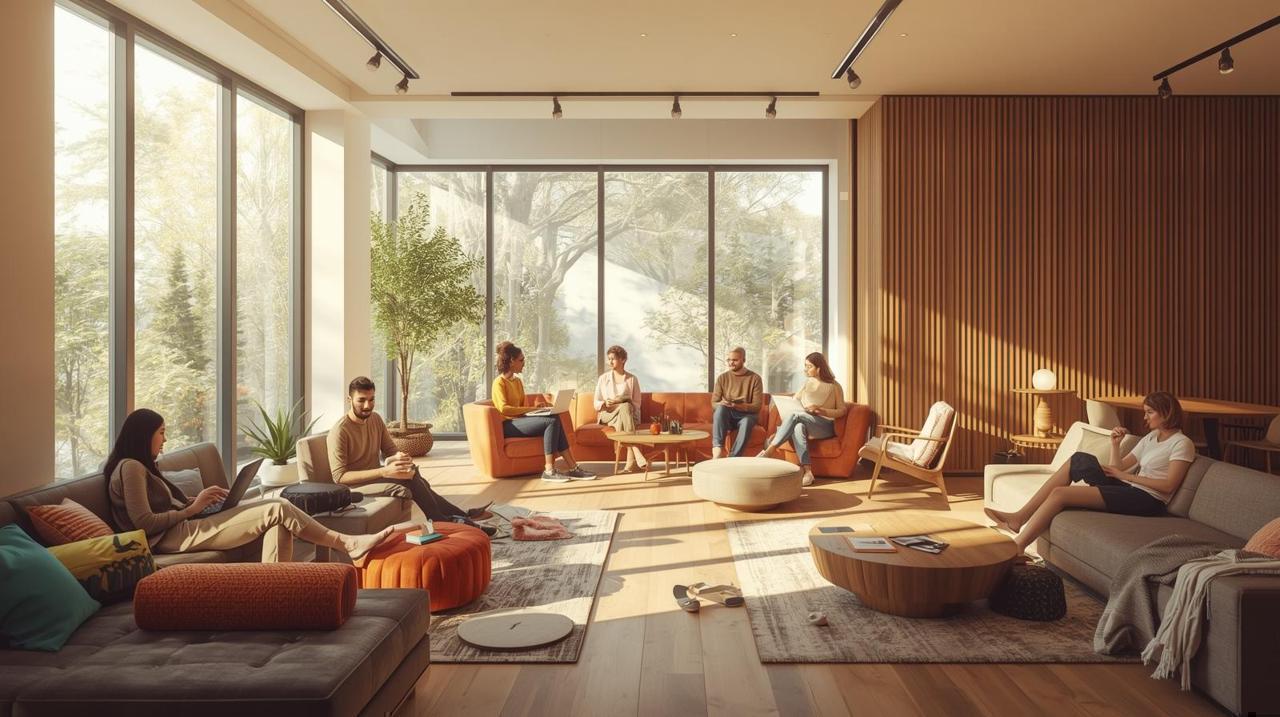
Join 10k+ people to get notified about new posts, news and tips.
Do not worry we don't spam!

Post by : Samjeet Ariff
In today’s fast-paced cities, finding a home that’s both affordable and community-driven can feel nearly impossible. Rent prices are climbing, traditional leases are restrictive, and urban lifestyles are evolving faster than ever. Enter co-living spaces — a modern housing concept designed specifically for urban professionals, freelancers, and remote workers who crave flexibility, comfort, and a sense of belonging.
Co-living is not just a trend; it’s a transformative shift in urban housing. These shared living environments are reshaping how people live, work, and connect — offering affordability, convenience, and social engagement all under one roof.
Co-living refers to a modern form of shared housing where residents have private rooms but share common spaces such as kitchens, lounges, and work areas. It’s an upgraded version of traditional shared apartments, blending the comforts of home with the convenience of a hotel and the community of a social club.
Unlike traditional rentals, co-living spaces often come fully furnished, with utilities, Wi-Fi, housekeeping, and community events included in the rent. Residents can move in without worrying about maintenance or long-term commitments — making co-living a perfect fit for young urban professionals and digital nomads.
In major cities like Dubai, London, New York, or Singapore, rental costs can eat up nearly half of a professional’s income. Co-living provides a cost-effective alternative by sharing resources and space while maintaining high living standards.
Residents enjoy premium amenities — fitness centers, coworking areas, and modern interiors — at a fraction of the cost of renting a studio apartment. With utilities and cleaning often included, budget management becomes simpler and stress-free.
Living in a big city can feel isolating, especially for newcomers. Co-living solves this problem by fostering a sense of community and connection. Residents can easily meet like-minded professionals through events, workshops, or shared lounges.
For freelancers, entrepreneurs, and remote workers, these spaces often double as networking hubs — a place where collaboration happens naturally. It’s not uncommon for co-living residents to team up on business ideas, creative projects, or social initiatives.
Unlike traditional leases that require year-long commitments and security deposits, co-living spaces offer flexible rental terms — from weekly to monthly stays. This appeals to people with dynamic careers or those frequently moving between cities.
Most co-living companies also provide app-based management systems, allowing residents to handle payments, maintenance requests, and event bookings digitally. It’s modern living designed for the digital age.
Forget the stress of furniture shopping or dealing with utility setups. Co-living spaces are turnkey homes — move-in ready with everything included. From stylish interiors to high-speed internet and shared entertainment zones, the goal is to make urban living as seamless as possible.
For busy professionals, this means more time to focus on work and personal goals, and less time worrying about logistics.
Modern co-living spaces often include coworking zones, wellness studios, and social lounges — encouraging both productivity and relaxation. For professionals working remotely or managing hybrid schedules, this setup allows them to maintain a healthy work-life balance within the same environment.
With dedicated workspaces, it becomes easier to separate professional tasks from personal time, improving overall mental well-being and performance.
The rise of remote and hybrid work models has played a massive role in the growth of co-living spaces. As work becomes more flexible, so do living arrangements. Professionals no longer need to live close to their offices — they seek comfortable, community-driven environments that fit their digital lifestyles.
Co-living spaces cater to this demand by offering:
High-speed internet and ergonomic workstations for productivity.
Global networks of properties, allowing members to move easily between cities.
Collaborative communities that promote innovation and creativity.
This lifestyle particularly attracts digital nomads, freelancers, and entrepreneurs who want to balance work, travel, and social interaction.
Beyond affordability and convenience, co-living promotes sustainable living practices. By sharing resources — from utilities to appliances — energy consumption and waste are significantly reduced. Many operators also use eco-friendly materials and smart technologies to minimize their environmental impact.
For environmentally conscious professionals, co-living aligns perfectly with sustainable urban living goals, offering both comfort and responsibility.
The co-living industry has grown rapidly across major global cities. According to property market reports, the global co-living market size is projected to exceed $45 billion by 2030, driven by millennial demand, housing shortages, and changing lifestyle preferences.
Regions leading this trend include:
Asia-Pacific: Cities like Singapore, Hong Kong, and Bangalore are witnessing a co-living boom due to rising real estate prices and a young working population.
Europe: London, Berlin, and Amsterdam are seeing increased investments in co-living real estate.
Middle East: Dubai’s luxury co-living developments are attracting digital professionals and entrepreneurs from around the world.
This growth signals a long-term shift in how people view urban housing — from ownership to access, from isolation to community.
While co-living offers numerous benefits, it’s not without challenges. Some of the key concerns include:
Privacy: Sharing common areas can feel intrusive to those used to living alone.
Compatibility: Conflicts may arise if residents have clashing lifestyles or values.
Regulation: Many cities still lack clear policies on co-living, creating legal uncertainties for developers.
To overcome these, successful co-living operators focus on community curation, where residents are matched based on shared interests and values, ensuring smoother coexistence.
From an investor’s point of view, co-living is one of the most promising real estate segments today. It offers:
Higher yields per square foot due to shared spaces.
Consistent occupancy rates, as demand among young professionals remains high.
Lower vacancy risk, with flexible and short-term leasing options.
Developers are also exploring hybrid models — combining co-living with co-working and wellness centers — to maximize returns and appeal to diverse audiences.
In markets like Dubai, London, and Singapore, co-living is evolving into a lifestyle brand, offering curated experiences rather than just accommodation.
The continued urban migration, combined with lifestyle shifts and digital work trends, ensures that co-living isn’t just a passing phase. It’s becoming a long-term solution to urban living challenges — blending affordability, sustainability, and social connection.
As cities grow denser and property ownership becomes more challenging, co-living represents the perfect middle ground: a way to live well without financial strain or isolation.
Co-living spaces are more than just a place to stay — they’re a lifestyle movement that captures the spirit of modern urban living. For professionals juggling careers, networking, and personal growth, these communities offer a balance of convenience, community, and comfort that traditional housing can’t match.
As the world continues to evolve, co-living is redefining what it means to live in a city — turning shared spaces into shared experiences, and transforming the future of housing for a new generation of professionals.










Mitchell Marsh Backs Aggressive Plan Ahead of India T20 Series
Australia captain Mitchell Marsh says his team will continue playing fearless cricket as they prepar

Smriti Mandhana Becomes World’s No.1 ODI Batter
India’s Smriti Mandhana rises to No.1 in ICC Women’s ODI rankings with a career-best rating of 828 a

Suryakumar Yadav Focuses on Team Spirit and Fielding Goals
India captain Suryakumar Yadav stresses teamwork, energy, and stronger fielding efforts ahead of the

Sherwood Leads Canucks to Overtime Win Against Oilers
Kiefer Sherwood scored twice, including an overtime winner, as Vancouver Canucks defeated Edmonton O

Freeman Leads Dodgers to 6-5 Thriller Over Blue Jays
Freddie Freeman’s 18th-inning walk-off homer gives the Dodgers a thrilling 6-5 win over the Blue Jay

Bayern Target Another Victory in German Cup Match
Bayern Munich look to continue their perfect start to the season with a German Cup clash against Col